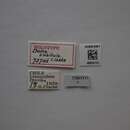Comprehensive Description
(
الإنجليزية
)
المقدمة من Smithsonian Contributions to Zoology
Doina subicula
Alar expanse 24–25 mm.
Labial palpus fuscous; second segment with longitudinal area and apex buff; third segment apex buff. Antenna fuscous; scape with buff spot dorsally at apex. Head drab, side tufts and frons infuscated. Thorax drab suffused fuscous, tegula fuscous with light ochraceous-buff apex. Forewing ground color fuscous; basal angle light ochraceous buff; on costa, to apex, a series of ill-defined light ochraceous-buff dots; in cell a blackish dash joined at end of cell by a transverse bar of the same color; between cell and termen an ill-defined, outwardly curved series of light ochraceous-buff spots; termen narrowly edged blackish fuscous; cilia drab and fuscous, tipped with sordid buff; underside of costa buff. Hind wing light grayish olive with darker line around outer edge; cilia light grayish olive. Foreleg buff overlaid fuscous on outer side; tarsal segments annulated buff; midleg similar but tibia with two buff annuli; hind leg buff with some infuscation on tibia and tarsal segments. Abdomen buff with median fuscous line dorsally and series of four indistinct fuscous spots laterally.
Male genitalia slide USNM 24257. Harpe ample, tapering slightly to rounded cucullus; base of inner surface clothed with cluster of stout setae; sacculus narrowly sclerotized. Gnathos a broad, transverse, subtriangular spined knob. Uncus as long as tegumen, hood shaped, narrowed posteriorly. Vinculum U-shaped. Tegumen nearly as broad as long, lightly scobinate laterally. Anellus a small, sclerotized plate with large flattened lateral lobes. Aedeagus stout, pointed, strongly curved, and bulbous basally; vesica with elongate roughened area.
HOLOTYPE.—USNM 73705.
TYPE-LOCALITY.—Chile, Llanquihue, Peulla.
Described from the male holotype (7 Mar 1959, J.F.G. Clarke) and one male paratype with identical data.
The nearest relative of this is D. phaeobregma, from which it is distinguished by the darker ground color and the presence of the light ochraceous-buff basal angle absent in D. phaeobregma. The male genitalia are similar but the gnathos of D. subicula is short and broad, that of D. phaeobregma long and narrow.
- الاقتباس الببليوغرافي
- Clarke, J. F. Gates. 1978. "Neotropical Microlepidoptera, XXI : new genera and species of Oecophoridae from Chile." Smithsonian Contributions to Zoology. 1-80. https://doi.org/10.5479/si.00810282.273

